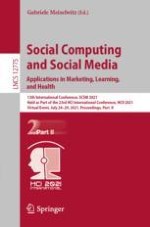2021 | Buch
Social Computing and Social Media: Applications in Marketing, Learning, and Health
13th International Conference, SCSM 2021, Held as Part of the 23rd HCI International Conference, HCII 2021, Virtual Event, July 24–29, 2021, Proceedings, Part II
herausgegeben von: Dr. Gabriele Meiselwitz
Verlag: Springer International Publishing
Buchreihe : Lecture Notes in Computer Science
